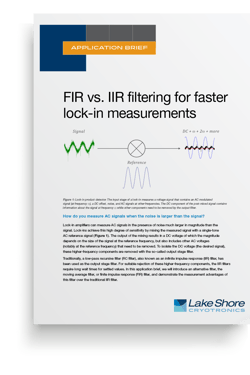When characterizing a device, you often look for a small response to some sort of stimulus, such as AC current. But frequently, this is being done in the presence of a DC offset as well as a lot of noise — which often can be larger than the signal itself. The typical way to obtain the sought-after level of response is to use a lock-in amplifier.
The output stage filter is a key component of lock-in detection. Traditionally, a low-pass recursive filter (RC filter), also known as an infinite impulse response (IIR) filter, has been  used as the output filter on lock-in amplifiers. The issue is, for suitable rejection of higher-frequency components, IIR filters require long wait times for settled values.
used as the output filter on lock-in amplifiers. The issue is, for suitable rejection of higher-frequency components, IIR filters require long wait times for settled values.
In this new app brief, we examine using a different type of filter: the moving average filter or finite impulse response (FIR) filter. We discuss the performance of the two filtering methods and demonstrate measurement advantages of this filter over the traditional IIR filter while describing the output filter feature of our MeasureReady™ M81-SSM synchronous source measure system.

